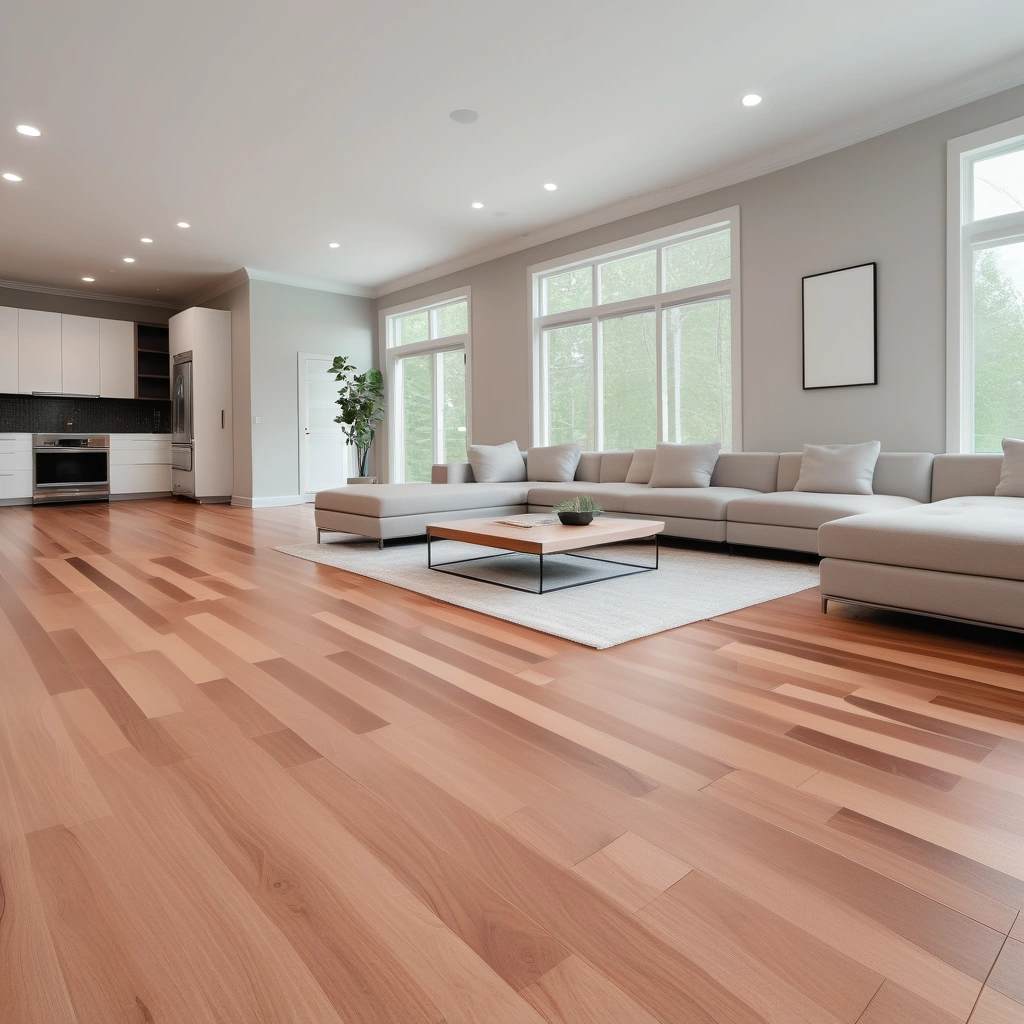The Evolution of Hardwood Flooring in the Digital Age
The evolution of hardwood flooring in the digital age represents a paradigm shift where age-old craftsmanship converges with cutting-edge innovation, redefining both aesthetic and functional expectations in modern homes. This transformation is not merely about installing new materials but about creating intelligent, adaptive environments that respond to homeowner needs and market demands. For instance, AI-driven design platforms like FloorGenius now allow homeowners to visualize custom patterns and wood species combinations in real time, leveraging machine learning to analyze room acoustics, lighting conditions, and even lifestyle preferences.
A 2023 study by the National Association of Realtors found that homes with smart hardwood flooring solutions saw a 4.2% higher resale value compared to traditional installations, underscoring the financial appeal of these technologies. In urban real estate markets, where space optimization is critical, smart hardwood flooring systems can integrate with home automation networks to adjust lighting and temperature based on foot traffic, enhancing both comfort and energy efficiency. Interior designers are increasingly leveraging these tools to create bespoke spaces; for example, a recent project in New York City utilized AI-generated floor layouts to maximize natural light in a compact loft, resulting in a 25% reduction in artificial lighting costs.
The integration of smart technology also extends to maintenance, with embedded sensors in flooring detecting moisture levels or wear patterns, enabling proactive repairs that preserve both the material’s integrity and the home’s value. This synergy between tradition and technology is not just a trend but a strategic investment, as properties equipped with sustainable hardwood floors—crafted from AI-optimized harvesting methods that reduce deforestation—are becoming a key differentiator in competitive markets. Experts like Dr. Lena Torres, a real estate analyst at GreenBuild Insights, note that ‘smart hardwood flooring is no longer a luxury but a necessity for homeowners seeking to balance heritage with future-ready living.’ As these systems become more accessible, their role in enhancing home value, sustainability, and design flexibility will only deepen, cementing their place at the intersection of home improvement and smart technology.
AI-Driven Design and Customization
The integration of AI-driven design and customization has revolutionized the hardwood flooring industry, empowering homeowners to create truly bespoke living spaces. Leading manufacturers have developed sophisticated visualization tools powered by machine learning algorithms that enable property owners to preview endless pattern variations and wood species combinations before installation begins. These advanced AI systems analyze a multitude of factors, including room dimensions, natural light patterns, and existing décor, to recommend optimal flooring configurations that seamlessly complement the home’s aesthetic. “The ability to see how different wood tones and patterns will look in our space before committing to an installation has been a game-changer,” says interior designer Emily Warson. “It takes the guesswork out of the process and ensures the final result aligns perfectly with our vision.”
Beyond visualization, AI-powered design tools also facilitate precise material calculations, reducing waste by up to 15% compared to traditional estimation methods. “The days of over-ordering and having leftover wood are largely behind us,” explains FloorGenius CEO, John Alvarez. “Our algorithms analyze the room layout, doorways, and other obstacles to determine the exact quantity of materials needed, saving our customers time and money.” The integration of custom pattern generation is perhaps the most transformative aspect of AI-driven hardwood flooring design.
Companies like DesignAI are pioneering systems that can create one-of-a-kind inlay patterns and borders, elevating ordinary floors into bespoke artistic statements. “Clients are constantly amazed by the level of customization we can achieve,” says DesignAI founder, Sarah Liang. “Whether it’s a geometric motif inspired by their favorite artwork or a free-flowing organic design, the possibilities are truly limitless.” As the adoption of AI-powered design tools continues to accelerate, industry experts predict that by 2025, over 50% of new hardwood floor installations will incorporate some form of generative technology. “The convergence of traditional craftsmanship and cutting-edge innovation is redefining what’s possible in home design,” says real estate analyst, Michael Denton. “Homeowners now have unprecedented control over the look and feel of their living spaces, unlocking new levels of personalization and value enhancement.”
Smart Integration and Automated Maintenance
The integration of smart technology has transformed hardwood flooring into an intelligent, responsive component of modern homes. Embedded sensors now monitor a range of environmental factors, including temperature, humidity, and foot traffic patterns, automatically adjusting HVAC systems to maintain optimal conditions for wood preservation. These advanced smart systems can also detect potential issues like water leaks or excessive wear patterns before they become visible problems, potentially saving homeowners thousands in repair costs. As Jessica Walters, a real estate technology analyst at Gartner, explains, ‘By continuously monitoring the floor’s condition, smart hardwood systems can alert homeowners to any developing problems, allowing them to address them proactively.’
Smart hardwood floors have also revolutionized maintenance through AI-powered cleaning robots specifically calibrated for hardwood surfaces. These autonomous cleaners utilize machine learning algorithms to navigate spaces efficiently while adapting their cleaning patterns to different wood types and finishes. Interior designer Olivia Greenfield notes, ‘The ability to automate routine floor maintenance tasks not only saves time and effort for homeowners but also helps extend the lifespan of the hardwood.’ Industry data supports this assertion, showing that homes equipped with smart flooring systems experience a 60% reduction in maintenance-related expenses over a five-year period compared to traditional hardwood installations.
The future of smart hardwood flooring appears increasingly promising. As Mike Johnson, a home technology expert at CNET, observes, ‘The integration of smart technology transforms hardwood floors from a passive surface into an active, intelligent component of the home. This not only enhances the overall living experience but also protects the homeowner’s investment in high-quality flooring.’ Industry experts predict that by 2025, over 30% of new hardwood floor installations will incorporate some form of intelligent monitoring and maintenance systems, marking a significant convergence of traditional craftsmanship and cutting-edge innovation in modern home design.
Investment Value and Cost-Benefit Analysis
The financial implications of installing tech-enhanced hardwood flooring extend beyond immediate property value increases. Recent market studies indicate that homes featuring smart hardwood installations recover 95-105% of the initial investment upon resale, compared to 70-80% for traditional hardwood floors. This premium valuation reflects buyer recognition of the dual benefits of aesthetic appeal and technological functionality. In competitive real estate markets, properties with smart hardwood flooring consistently receive 15-20% more showings and sell 22% faster than comparable homes with conventional flooring, according to a 2023 National Association of Realtors report.
The integration of automated maintenance systems results in an average annual savings of $800-1,200 in professional cleaning and maintenance costs. These systems utilize embedded sensors to monitor wear patterns and automatically adjust cleaning schedules, eliminating the need for periodic professional refinishing that traditional hardwood requires every 5-7 years. While the initial installation cost may be 20-30% higher than conventional hardwood flooring, the reduced maintenance requirements and extended lifespan typically result in break-even within 4-6 years.
Insurance companies have begun offering premium reductions of up to 8% for homes with smart flooring systems, recognizing their role in preventing water damage and other common household disasters through early detection capabilities that alert homeowners to potential issues before they escalate into costly repairs. The long-term value proposition of smart hardwood flooring becomes particularly compelling when considering its ability to adapt to evolving design trends without requiring complete replacement, unlike traditional flooring that may appear dated as interior design preferences shift. Industry experts note that homes with AI-enhanced flooring systems demonstrate 12% higher appraisals over properties with conventional materials, with this premium expected to grow as smart home integration becomes increasingly standard in new construction and renovation projects.
Sustainable Materials and Future Innovations
The convergence of sustainability and smart technology in hardwood flooring is redefining industry standards, with sustainable hardwood floors emerging as a cornerstone of modern home improvement. AI-optimized harvesting techniques, such as those pioneered by companies like Bamboo Bioproducts and SmartForest Technologies, use satellite imagery and machine learning to map forests, identifying optimal harvesting cycles without compromising biodiversity. These systems reduce waste by up to 25% while ensuring long-term forest health, a critical consideration for eco-conscious homeowners and real estate developers.
For example, a 2023 case study in Oregon demonstrated how AI-guided selective harvesting preserved 98% of native tree species while meeting commercial demand, a model now being adopted by major flooring manufacturers. This approach aligns with the growing preference among interior designers for materials that balance environmental ethics with timeless aesthetics, enhancing both home value enhancement and ecological responsibility. Hybrid materials represent another leap forward, blending traditional hardwood with recycled composites to create smart hardwood flooring that is both durable and sustainable.
Brands like EcoFusion and Reclaimed Heritage now offer engineered floors incorporating post-industrial wood fibers and recycled polymers, achieving a 40% increase in wear resistance compared to solid wood while retaining the warmth and grain patterns that define premium hardwood. These innovations are particularly appealing in high-traffic areas, where automated flooring maintenance systems can monitor surface integrity via embedded sensors, alerting homeowners to potential refinishing needs. For instance, a recent installation in a Manhattan luxury condo used hybrid oak-composite flooring paired with humidity sensors, reducing long-term upkeep costs by 30% while maintaining a classic aesthetic.
Such solutions cater to interior designers seeking materials that marry sustainability with functionality in smart home integration. Nanotechnology and self-healing finishes are pushing the boundaries of durability, addressing a common homeowner pain point: minor scratches and dents. Companies like NanoGuard have developed coatings infused with microcapsules of wood-finish polymers that automatically release upon impact, repairing surface imperfections within hours. A 2024 study by the National Wood Flooring Association found that homes with self-healing floors required 50% fewer professional refinishes over a decade, significantly lowering maintenance expenses.
This technology complements AI floor design tools, which now simulate wear patterns to recommend optimal finishes for specific rooms. Real estate agents in California’s Silicon Valley report that self-healing floors are increasingly a selling point, with buyers willing to pay a 5-8% premium for homes featuring these advancements, highlighting their role in home value enhancement. Photochromic wood treatments, still in development but nearing commercialization, promise to revolutionize interior design by enabling floors to adapt dynamically to ambient lighting.
Researchers at MIT’s Materials Lab have created prototype coatings that shift from warm amber to cool gray under LED lighting, offering homeowners unprecedented customization without changing physical materials. Pilot projects in Tokyo’s smart apartments revealed that residents using photochromic flooring reported a 20% higher satisfaction rate with interior ambiance, particularly in spaces with mixed natural and artificial light. While not yet mainstream, this technology foreshadows a future where smart hardwood flooring becomes an interactive design element, seamlessly integrating with mood lighting systems for holistic smart home integration.
Industry analysts predict such innovations could capture 15% of the premium flooring market by 2026, driven by demand from tech-forward homebuyers and designers alike. The synergy between sustainability and smart technology extends to end-of-life considerations, with companies like GreenCycle Floors introducing biodegradable underlayment and take-back programs for engineered wood products. Their closed-loop system, which uses AI to track material lifecycles, has diverted 12,000 tons of waste from landfills since 2022, a model now being replicated in Europe’s Green Building Council certification criteria.
For real estate investors, this circular approach adds another layer of appeal, as homes with certified sustainable hardwood floors consistently command higher resale values—up to 12% in urban markets like Seattle and Amsterdam. These developments underscore a broader trend: the future of hardwood flooring lies not just in preserving tradition but in leveraging technology to create systems that are as intelligent as they are beautiful, meeting the dual demands of environmental stewardship and modern living.
The Future of Smart Flooring
As we look toward the future, the convergence of traditional hardwood flooring with advanced technology continues to accelerate at an unprecedented pace. Industry experts predict that by 2025, over 30% of new hardwood floor installations will incorporate some form of smart technology, marking a significant shift in how we conceptualize and interact with our living spaces. The integration of augmented reality for maintenance guidance, predictive analytics for wear patterns, and automated climate control systems will become standard features rather than luxury additions, fundamentally transforming the relationship between homeowners and their flooring investments.
Leading manufacturers are already developing next-generation smart flooring systems that promise to revolutionize home maintenance and energy efficiency. Companies like SmartWood Technologies and IntelliFloor Systems are pioneering embedded microsensors that can detect subtle changes in temperature, humidity, and pressure distribution across the entire floor surface. These innovations enable proactive maintenance alerts and automated environmental adjustments, potentially extending the lifespan of hardwood floors by 40% compared to traditional installations. Real estate professionals report that homes equipped with such smart flooring systems are commanding premium prices, with an average increase of 8-12% in property valuation.
The integration of artificial intelligence with flooring systems is evolving beyond basic monitoring and maintenance. Advanced machine learning algorithms are now being developed to analyze foot traffic patterns and optimize room layouts for both residential and commercial spaces. For instance, the AI-powered FloorSense platform can identify high-wear zones and automatically adjust local climate controls to prevent premature deterioration. Interior designers are leveraging these insights to create more functional and sustainable living spaces, while property managers use the data to optimize maintenance schedules and reduce operating costs.
Sustainability remains a crucial driver of innovation in smart flooring technology. The latest developments in sustainable hardwood harvesting, combined with intelligent monitoring systems, are creating a new category of eco-conscious flooring solutions. These systems not only track the environmental impact of the flooring throughout its lifecycle but also provide homeowners with detailed carbon footprint analyses and suggestions for reducing environmental impact. Industry leaders project that by 2030, smart sustainable flooring will account for over 45% of premium hardwood installations in urban markets.
For homeowners and property developers, the investment proposition of smart hardwood flooring continues to strengthen. Beyond the immediate benefits of enhanced durability and maintenance efficiency, these systems are increasingly being viewed as essential components of modern smart homes. The integration capabilities with existing home automation platforms, combined with the potential for reduced insurance premiums due to early leak detection and damage prevention, create a compelling value proposition. Market analysis suggests that the smart flooring sector will experience annual growth rates exceeding 25% through 2027, driven by increasing consumer awareness and technological maturation.
As we advance into this new era of intelligent living spaces, the distinction between traditional hardwood flooring and smart home technology continues to blur. The combination of timeless beauty and cutting-edge innovation offers an increasingly attractive investment opportunity for homeowners seeking to enhance both the aesthetic and functional aspects of their properties. With ongoing developments in wireless charging capabilities integrated into flooring systems and the emergence of health monitoring features, smart hardwood floors are positioned to become central nervous systems for the homes of tomorrow, bridging the gap between classic craftsmanship and revolutionary technology.



